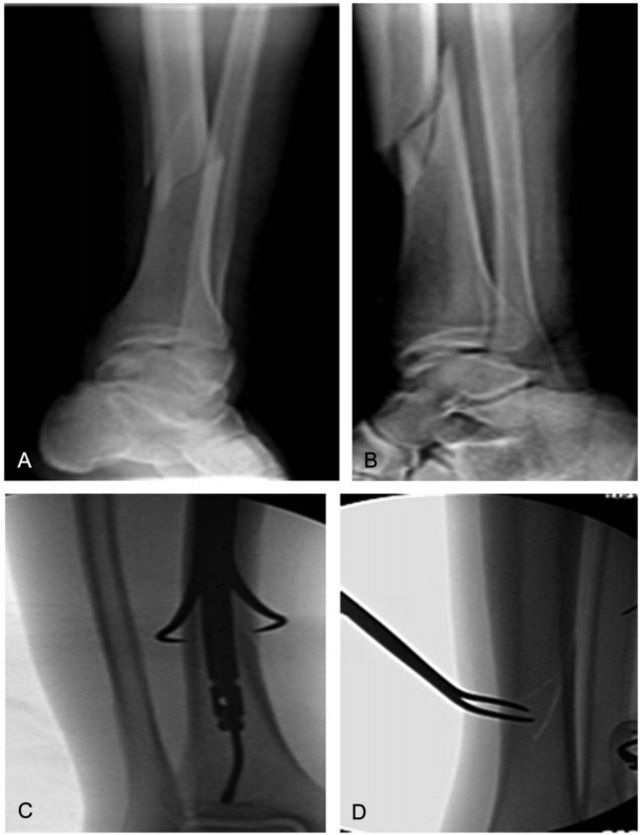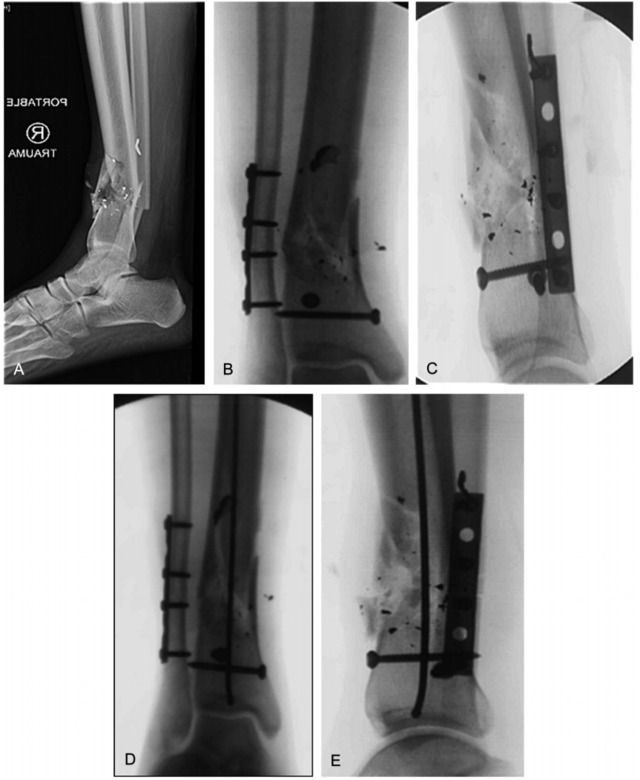Déi zwou Zeilen aus dem Gedicht „cut and set internal fixation, closed set intramedullary nailing“ spigelen treffend d'Astellung vun orthopädesche Chirurgen zur Behandlung vun distalen Tibiafrakturen erëm. Bis haut ass et nach ëmmer eng Meenungsfro, ob Plackeschrauwen oder intramedullär Neel besser sinn. Egal wat a Gottes Ae wierklech besser ass, haut maache mir en Iwwerbléck iwwer d'chirurgesch Tipps fir d'intramedullär Neelverschluss vun distalen Tibiafrakturen.
Preoperatives "Ersatzrad"-Set
Obwuel routineméisseg präoperativ Virbereedunge net néideg sinn, ass et recommandéiert, e Ersatzsatz u Schrauwen a Placken ze hunn, fir de Fall vun onvirgesinnten Ëmstänn (z. B. eng verstoppt Frakturlinn, déi d'Plazéierung vu Sperrschrauwen verhënnert, oder e mënschleche Feeler, deen d'Fraktur verschäerft an eng Immobiliséierung verhënnert, asw.), déi duerch d'Benotzung vun intramedullärer Neelvernägelung entstoe kënnen.
Déi 4 Grondlage fir eng erfollegräich Repositionéierung
Wéinst der schiefer Anatomie vun der distaler Tibiametaphyse kann eng einfach Traktioun net ëmmer zu enger erfollegräicher Repositioun féieren. Déi folgend Punkte wäerten hëllefen, d'Erfolgsquote vun der Repositionéierung ze verbesseren:
1. präoperativ oder intraoperativ Orthopantomogrammer vum gesonde Gliedmaass maachen, fir den Ausmooss vun der Frakturreduktioun op der betroffener Säit ze vergläichen an ze bestëmmen.
2. eng hallef gebéit Knéipositioun benotzen fir d'Nagelplazéierung an d'Fluoroskopie ze erliichteren
3. Benotzt e Retraktor fir d'Gliedmaass op der Plaz an an der Längt ze halen
4. Setzt Schanz-Schrauwen an déi distal an proximal Tibia fir d'Frakturreduktioun ze ënnerstëtzen.
7 Detailer vun der assistéierter Reduktioun an Immobiliséierung
1. Setzt de Führungsstift korrekt an d'distal Tibia mat engem passenden Hëllefsmëttel oder andeems Dir d'Spëtzt vum Führungsstift virum Plazéieren virbéit.
2. Benotzt eng Hautspëtz-Resurfacing-Pinzette fir intramedullär Neel a spiralfërmegen a schréie Frakturen ze placéieren (Figur 1)
3. eng steif Plack mat monokortikaler Fixatioun (tabulär oder Kompressiounsplack) an oppener Reduktioun benotzen, fir d'Reduktioun bis zum Asetzen vum intramedullären Nagel z'erhalen
4. Verengung vum intramedulläre Nagelkanal mat Hëllef vu Blockschrauwen fir d'Wénkelung an de Kanal ze korrigéieren, fir den Erfolleg vun der intramedullärer Nagelplazéierung ze verbesseren (Figur 2)
5. Jee no der Aart vun der Fraktur, entscheet ob Fixatiounsschrauwen an eng temporär Blockéierungsfixatioun mat Schnee- oder Kirschner-Stiften benotzt solle ginn.
6. nei Frakturen verhënneren wann Blockschrauwen bei osteoporotesche Patienten benotzt ginn
7. als éischt d'Fibula fixéieren an dann d'Tibia am Fall vun enger kombinéierter Fibulabroch, fir d'Tibialrepositionéierung ze erliichteren
Figur 1 Perkutan Weber-Klammer-Repositionéierung Schréi Biller (Figuren A an B) suggeréieren eng relativ einfach distal Tibiafraktur, déi sech fir fluoroskopesch perkutan minimalinvasiv schaarfnueseg Klammer-Repositionéierung eidel mécht, déi wéineg Schued um Weichgewebe verursaacht.
Abb. 2 Benotzung vu Blockschrauwen Abb. A weist eng staark komminutéiert Fraktur vun der distaler Tibiametaphyse, gefollegt vun enger posteriorer Angulatiounsdeformitéit, mat enger restlecher Inversiounsdeformatioun no der Fibularfixatioun trotz der Korrektioun vun der sagittaler posteriorer Angulatiounsdeformitéit (Abb. C) (Abb. B), mat enger Blockschrauf posterior an enger lateral um distalen Enn vun der Fraktur placéiert (Abb. B an C), an enger medullärer Dilatatioun nodeems d'Führungsstifte placéiert goufen, fir d'Koronaldeformitéit weider ze korrigéieren (Abb. D), wärend d'sagittalt Gläichgewiicht erhale bleift (E)
6 Punkte fir intramedullär Fixatioun
- Wann de distale Knach vun der Fraktur genuch knacheg ass, kann den intramedulläre Nagel fixéiert ginn andeems 4 Schrauwen a verschiddene Wénkelen agesat ginn (fir d'Stabilitéit vu verschiddenen Achsen ze verbesseren), fir d'strukturell Steifheet ze verbesseren.
- Benotzt intramedullär Neel, déi et den agesate Schrauwen erlaben, duerchzegoen an eng Verriegelungsstruktur mat Winkelstabilitéit ze bilden.
- Benotzt déck Schrauwen, verschidde Schrauwen a verschidde Flächen vun der Schrauwenplacement, fir d'Schrauwen tëscht dem distalen an proximalen Enn vun der Fraktur ze verdeelen, fir den Fixatiounseffekt vum intramedulläre Nagel ze verstäerken.
- Wann den intramedulläre Nagel ze wäit placéiert ass, sou datt de virgebogenen Führungsdrot eng distal Tibialexpansioun verhënnert, da kann e net-virgebogenen Führungsdrot oder en distale Net-Expansioun benotzt ginn.
- Behalen den Blockéierungsnagel a d'Plack bis d'Fraktur reduzéiert ass, ausser de Blockéierungsnagel verhënnert datt den intramedulläre Nagel de Knach ausbreet oder d'unikortikal Plack d'Weichgewebe beschiedegt.
- Wann déi intramedullär Neel a Schrauwen net fir eng adäquat Reduktioun a Fixatioun suergen, kann eng perkutan Plack oder Schrauf bäigefüügt ginn, fir d'Stabilitéit vun den intramedullären Neel ze erhéijen.
Erënnerungen
Méi wéi 1/3 vun den distalen Tibiafrakturen betreffen d'Gelenk. Besonnesch Frakture vum distalen Tibiastamm, spiralfërmeg Tibiafrakturen oder assoziéiert spiralfërmeg Fibularfrakturen sollten op intraartikulär Frakturen ënnersicht ginn. Wann dat de Fall ass, muss d'intraartikulär Fraktur separat behandelt ginn, ier en intramedullären Nagel placéiert gëtt.
Zäitpunkt vun der Verëffentlechung: 31. Oktober 2023












